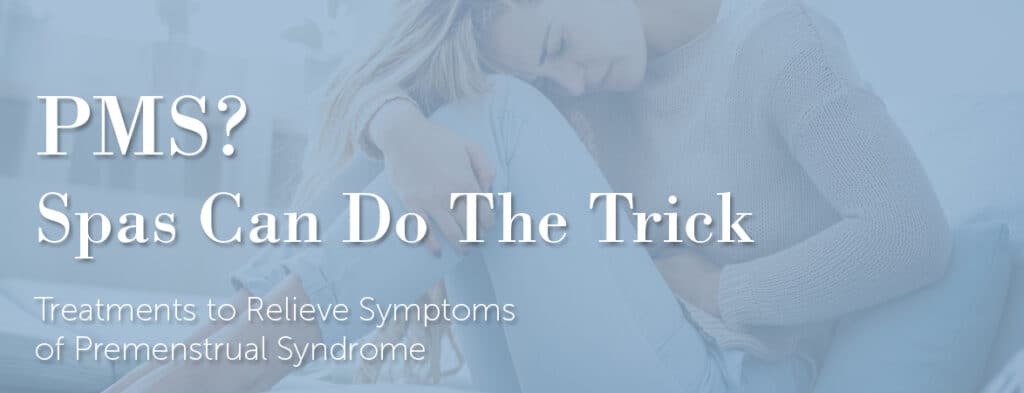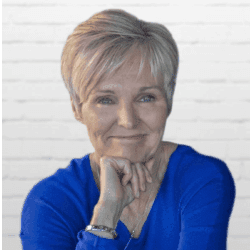PMS Symptom Relief
Over the past several decades, few medical conditions have received as much attention and stirred up as much controversy as PMS, the common term associated with premenstrual syndrome.

PMS? Spas Can Do The Trick
Treatments to Relieve Symptoms of Premenstrual Syndrome
Over the past several decades, few medical conditions have received as much attention and stirred up as much controversy as PMS, the common term associated with premenstrual syndrome. A few people might say that there is no such thing as premenstrual syndrome, but try telling that to scores of women who experience some kind of symptoms every month. Some estimate that PMS affects between 20 and 40 percent of menstruating women, with peak incidences occurring in their 30s and 40s. Many women experience mild symptoms, and at least one symptom with some regularity.
PREMENSTRUAL DYSPHORIC DISORDER (PMDD) VS. PREMENSTRUAL SYNDROME (PMS)
There are an estimated 5-10 percent of women who suffer with very severe symptoms. For these women, symptoms meet the criteria for premenstrual dysphoric disorder, or PMDD.
PMDD is a sometimes disabling extension of premenstrual syndrome. Underlying depression and anxiety are common in both PMS and PMDD, so it’s possible that the hormonal changes that trigger a menstrual period worsen the symptoms of existing mood disorders. Many women with PMDD meet criteria for major depressive disorders or seasonal affective disorder, and some have panic attacks or other symptoms of anxiety. The condition has a physiological basis, even though it may include psychiatric symptoms or coexist with other psychiatric disorders. In PMDD, at least one of these emotional and behavioral symptoms stands out:
- Extreme sadness or hopelessness
- Extreme anxiety, tension or panic attacks
- Extreme moodiness
- Marked irritability or anger, possibly leading to violent outbursts
AETIOLOGY
The pathogenesis of PMS is still uncertain. Suggestions include disruptions in hormones like progesterone and neurotransmitters such as serotonin, gamma aminobutaric acid, and of course the stress hormone cortisol. Other proposed causes are pyridoxine deficiency, excess prostaglandins production and increased Aldosterone production in the luteal phase. In terms of lifestyle, being sedentary, consuming large amounts of caffeine, sugar and alcohol, and poor stress management are some of the suggested contributing factors of PMS.
Although PMS is now recognized as a legitimate, cyclical set of physical, psychological and behavioral symptoms that begin two to 14 days before menstruation and end when the menstrual flow begins, part of the confusion surrounding it is due to the vast number of symptoms reported.
In an attempt to bring some order to the clinically and metabolically confusing picture of PMS, Guy Abraham, M.D., has divided PMS into four distinct subgroups according to specific symptoms and hormonal patterns. The following can help determine which group your client falls into, and hence what sort of treatment can be offered to her in the spa.
PMS Type A – Anxiety
Causes: low progesterone levels
Symptoms of nervous tension, anxiety, mood swings and irritability are characteristic of this group. Biochemically, this group shows a high estrogen to progesterone ratio in the luteal phase.
PMS Type C – Cravings
Causes: low blood sugar and low prostaglandins
This group shows increased appetite, sweet cravings, headaches, fatigue, fainting and heart pounding.
PMS Type D – Depression
Causes: low estrogen levels
Depression, crying, forgetfulness, confusion and insomnia characterize this group.
PMS Type H – Hyper-hydration
Causes: excess sodium
Fluid retention, weight gain, swelling of extremities, breast tenderness and abdominal bloating characterize this group.

AROMATHERAPY/ESSENTIAL OILS FOR PMS TREATMENT STRATEGY
In using essential oils for treatment, remember that all essential oils are not created equal. Ensure that you use the highest quality oils in order to achieve the desired results. Make sure your client understands that these essential oils should not be ingested under any circumstances.
Addressing Physical Symptoms
There are many effective ways to use essential oils for premenstrual syndrome, including both general and targeted solutions. Consider these two uses for general symptoms of PMS:
Prepare a hot aromatherapy bath using five to seven drops of essential oil. Place the oils in either a cup of full- fat milk or mix them with Epsom salts before adding them to the water to ensure they are not floating on top. Using this method, women can benefit from the inhalation of the oils to help with some of the emotional symptoms in addition to the physical ones. The heat of the bath can soothe the cramping, as well as joint and muscle pain associated with PMS.
The preferred and most effective option is to mix 20-25 drops of essential oil into 4 ounces of a base or carrier oil, such as a cold-pressed vegetable oil made from seeds, nuts or kernels of a plant (i.e. jojoba, sweet almond or apricot kernel oil). This can be applied to the body as needed throughout the day. Alternatively, the oils can be stirred into an unscented lotion and applied as a daily moisturizer. A compress can easily be used for the abdomen, lower back, or other areas of cramping by soaking a warm cloth in the essential oil mixture and applying it to the affected area.
For targeted solutions to specific symptoms, consider the following remedies. These blends and applications can be implemented into spa treatments or recommended to clients for home care between sessions.
- Headaches: The classic blend for headaches and migraines is a mix of lavender (antispasmodic), peppermint (analgesic and anaesthetic) and eucalyptus (antispasmodic and anti-neuralgic). Apply 2 drops of the essential oil blend in the form of a massage oil to the temples and back of the neck. For migraines, apply 6 drops over the liver area. Alternatively, make a warm or cold compress by soaking a warm cloth and adding 2 drops of the essential oil mixture and applying it to the affected area.
- Balancing hormones: The hormonal imbalances that accompany premenstrual syndrome can be addressed with a number of essential oils. Clary sage, sweet fennel, geranium and rose all influence the production of hormones. Add evening primrose oil to the massage blend and apply 6-8 drops to the torso at least three times daily.
- Menstrual cramps: Oils that are antispasmodic, emmenagogues and analgesics are necessary to address cramping. Cypress, clary sage, Roman chamomile lavender and peppermint in a massage blend work well. Apply 6 drops to the lower abdominal area and also the lower back if necessary.
- Fatigue: A combination of citrus oils such lemon, orange or grapefruit with essential oils of rosemary, geranium and basil can energize and rejuvenate feelings of fatigue. When diffusing the blend, no carrier oils are required. Put 4 drops of essential oil directly into the diffusing unit. When applied to the body in a cream or lotion use two pumps of product, one to the chest and one to the lower back over the adrenals.
- Insomnia: Lavender, Roman chamomile, sweet orange, mandarin, petitgrain, bergamot and valerian root are good options. These oils can be diffused, added to a bath or applied in an oil or cream to the body. To use in a bath, place 8 drops total of the combined essential oils, mix them into Epsom salts and then add to the bath. A relaxing massage is a definite treatment must for this symptom.
- Fluid retention, breast tenderness, bloating: Rosemary, lavender, sage, black pepper, juniper and marjoram create a powerful combination of oils to treat PMS-H. Following the massage oil guidelines above, make the blend and apply 6-8 drops frequently to the affected areas after showering or bathing. For breast tenderness, apply the oil on the side of the breast and work toward the armpit. In the spa, a lymphatic drainage treatment of the whole body is recommended, followed by regular home use of the recommended blend.
- Forgetfulness and confusion: A blend of basil, lime, peppermint and rosemary diffused into a room is an excellent way to sharpen focus and memory, a great idea for the spa therapist in the treatment room. Simply place 4 drops in your diffusing unit and enjoy. When caught short, simply place the drops on a tissue and inhale as frequently as needed.
For further trainings in aromatherapy contact your National Association for Holistic Aromatherapy. They offer certified and approved training at various levels.

Trish Green, a CIDESCO Diplomat, has been a teacher for 30 years. She is a doctor of homeopathy, an instructor of aromatherapy and a registered Bach flower practitioner. Green is owner of the Balnea Institute in Ontario, an educational facility dedicated to holistic esthetics and complementary therapies.

Written By Trish Green DiHom(Pract) B.Ed Cidesco Diplomat. Bach Flower Therapist.
Trish is a graduate of the Victoria University of Manchester, Trish is a teacher with 35 years of experience in the education field. For twenty of those years she has been an educator in the esthetics industry. She is an advocate for raising standards in education for Complementary Health Care Practitioners with special interest in Aromatherapy. Her career in the field of natural health and esthetics is wide and varied. From Doctor of Homeopathy to Cidesco diplomat, Trish is a dedicated professional, committed to ongoing education and the education of others.
